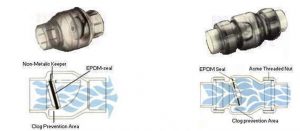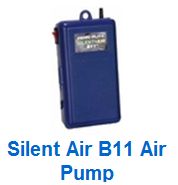Water circulation is undoubtedly the most important parameter for the successful fish only or reef tank. Without water circulation life will not exist; it provides oxygenated water, removes toxic gases like CO2, and transports nutrients throughout the man made biotope. Without water circulation, whether due to a power outage or pump failure, animals that need oxygen begin to die quite quickly. And, there are biochemical reasons for this.
Respiration
The vast majority of organisms that we keep in our marine tanks respire. They consume oxygen from their environment where it is transported via their circulatory system into their cells. This permits vital metabolism to occur within the cells. Also, as part of this cellular metabolism carbon dioxide (CO2) is produced. In human beings this is called breathing. We, however, extract oxygen from the air and release carbon dioxide into the air. This is significant because the animals we keep in our marine aquariums need to extract oxygen from water which contains far less oxygen then that of air. The result of that is that our marine fish for example must take in 10 to 30 times the volume of water than terrestrial animals take in from the air to respire successfully. It is therefore vitally important that we supply our critters with water that is constantly well oxygenated through aeration and or circulation.
Gas Exchange
Essentially our goal in creating a successful marine tank is to maintain as close as possible water that is saturated with oxygen and that successfully dispels carbon dioxide. Although aeration from an air stone, or better within the chamber of a protein skimmer contributes somewhat, most of the gas exchange takes place through the water’s surface. The air-water interface is where this gas exchange takes place, and anything that interferes with this vital exchange is dangerous to the health of our organisms. However, between the air and the water is a thin film called by oceanographers a laminar layer, which interferes with said gas exchange. The thinner this film the more efficient the gas exchange.
Laminar layer
In the ocean the thickness of the laminar layer ranges from 0.002 to 0.020 centimeters, mostly determined by surface agitation, like wave action.
How do we then thin or even get close to eliminating this laminar layer or skin, so that efficient gas exchange can take place? This layer is the result of pressure between the atmosphere and the water. Diffusion of gases through this layer increases in efficiency the thinner the laminar layer. The most direct way to promote gas exchange threw this layer is to agitate the water’s surface. On the simplest level stirring the water helps significantly. The can be done with a mechanical paddle or air bubbles breaking the surface. However, there are much better ways.
To complicate matters organic molecules made up of nitrogenous organic material and simple detritus collects on the surface, further impeding necessary gas exchange. When there is no or little surface agitation this organic slick is easily visible to the naked eye, especially when looked at from below the surface. Removal of surface water also aids in the transmission of light to the corals if you are plumbing a reef tank.
Surface Agitation – Plumbing Techniques
When it comes to plumbing a marine aquarium the first goal is to move water from all sections of the tank, especially the lower section to the surface, and at the same time breaking the surface tension. The best way to achieve this is with an overflow, which is the way that most reef keepers go.
http://www.youtube.com/watch?v=-zVGwdRVHU4
Whether you use a movable overflow box, or a built in inside box overflow the primary issue is capacity. In other words, can the siphon capacity handle the volume of water returned to the tank from the sump pump or pumps, whether said pump or pumps are in the sump or plumbed outside the sump? And, if you’re having the tank drilled be sure to plan for the future in terms of capacity. In a reef tank coral growth often requires greater water movement as growth becomes denser. Another virtue of surface skimming and overflow boxes is that in the event of a power outage the water level will not drop lower than the top of the overflow.
Caution: In the event of a power failure make sure that there is enough room in the sump for water that will flow into the sump from the display tank. Also, make sure that when the power returns an external overflow box is able to restart siphoning; otherwise the water from the sump will overflow the display tank. This is generally caused by air bubbles getting into the siphons. In fact, this can happen without a power outage. Many external overflow boxes have a nipple for sucking air out of the siphon chamber, and by attaching a small power head to that nipple air bubbles can be kept out of the siphon area. If the outside box uses siphon tubes be sure to check them regularly for air pockets. Remember Murphy’s law: whatever can go wrong will, and at the worst time.
Note: If you have a choice, choose an external pump, because it will transfer less heat into the tank water, and choose one that is energy efficient. On my 700-gallon reef tank I used in the past a Jacuzzi pump, which drew 10-amps, and when I switched to a Reeflo HammerHead pump the water temperature dropped 2 degrees-F, and my electric bill dropped almost $50.00 monthly. The HammerHead moved as much water, but drew only 3-amps – about 350-watts.
The Sump
What kind of sump you utilize is dependent on a number of factors: available space and size. Sumps can be purchased ready-made, or for the more adventurous they can be made. Because I have a pump room located behind the display tank I like to use Rubbermaid stock tanks. They are made of fiberglass, are quite strong, and easy to drill. They also come in sizes ranging from 50 to 300-gallons. See following picture:
In this setup I have two 150-gallon Rubbermaid stock tanks plumbed together with a 2-inch PVC pipe. Using a valve I can isolate the back sump, when I want to use it as a quarantine tank. As you can also see, you can place skimmers, heaters, carbon filters, and calcium reactors in these stock tanks.
Returns to Tank
It should be obvious by now that water circulation is essential; without it, after a relatively short time period – hours – life in your tank will begin to die. How water is returned to the display tank from the sump has two goals: one is to simply get water from the sump back into the display tank, the second is to supply circulation to all areas of the display tank. This can be done simply, or in a more complex way. My way is to utilize devices made by Ocean Motions which have return lines that alternate and heads that rotate creating random water circulation patterns in the display tank. See the following picture:
Caution: If you look carefully at the above picture you will notice that the 4 Ocean Motion returns are lower in the water than the top of the built in overflow box. In the event of a power failure or the failure of the return pump the returns will become siphons with the result that the water will return to the sump from the depth of the returns, which can overflow a sump that doesn’t have enough holding capacity. Furthermore, some aquarists think by using a check valve it will prevent water from siphoning back into the sump, which is what it is designed to do. Check valves will do this quite well when new; however, they tend to clog up after some months of use in seawater and leak. If you need to depend on one than plumb it surrounded by true union valves so that it can be removed for cleaning in a weak acid bath periodically. Incidentally, this is true of all valves; in seawater valves tend to freeze up with deposits of calcium. I make it a practice of turning them off and on vigorously at least once a month.
Defeating Murphy
Backup systems are important, even essential. I always have a second backup pump; in this case a second HammerHead already plumbed and ready to go if necessary. A pair of Haywood true union valves allow me to change pumps in minutes. Also, I never want to rely on one pump, and in this system the main circulation pump. I also use two internal water pumps made by vortech. And, in the event of a power outage I have 6 battery operated air pumps manufactured by Pennplax that are programmed to turn on if the electrical power goes out.
Notice how the return HammerHead pump is surrounded by true union valves, which allows me to remove the said pump in a matter of minutes. I keep a spare pump already plumbed ready to replace a failed pump. Using true union valves like these shown can also be used to remove and clean a check valve.
Vortech Pumps
I like vortech pumps because they are unobtrusive and move a lot of water. They can be placed low in the display tank, without worry about siphoning water out of the tank, and because their motor is outside of the tank they will not heat the water. They also come with a battery backup which is useful in the event of a power failure. Advanced Aquarist has reviewed this product twice, see:
Tip
You can notice from the plumbing setup in my reef that I use flexible PVC. This allows me to avoid elbows whenever possible. Elbows cause back pressure, reducing flow. Any questions, just post them following this column!





0 Comments